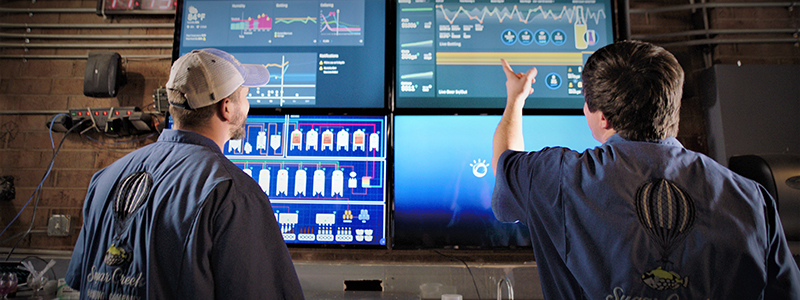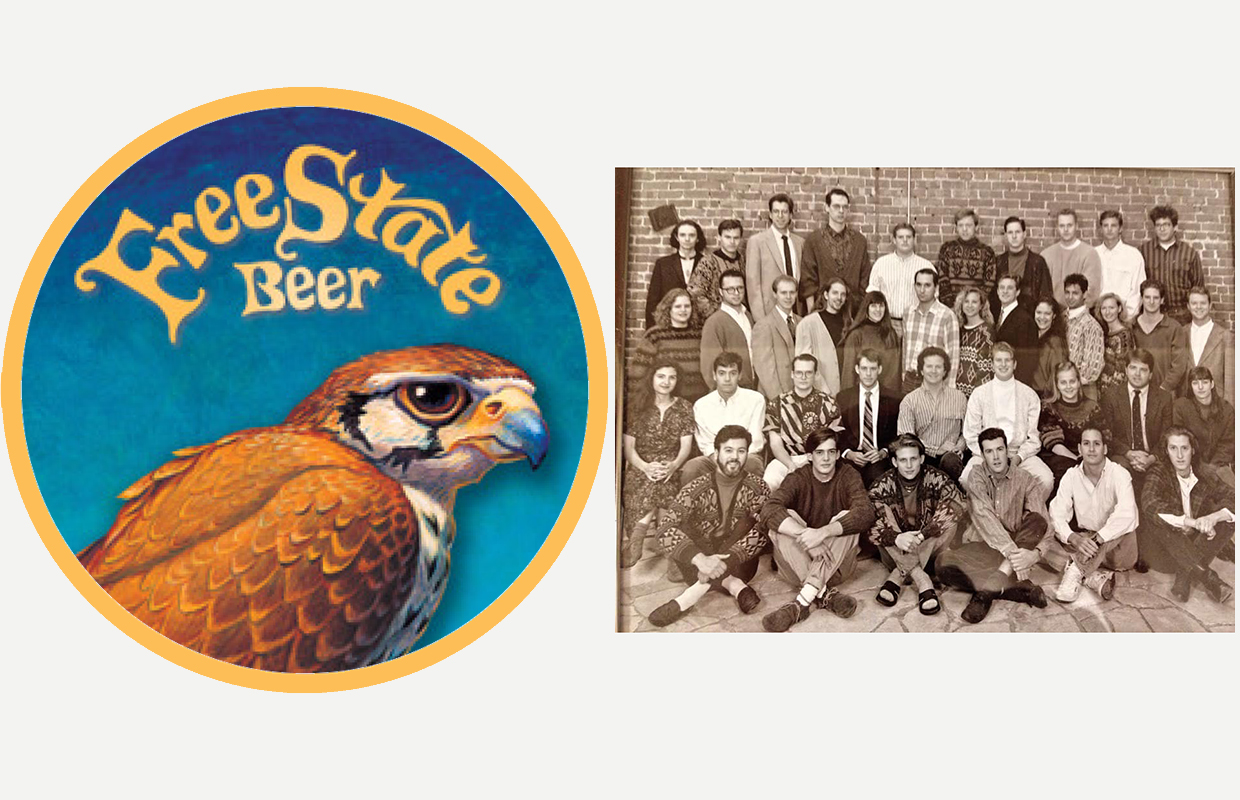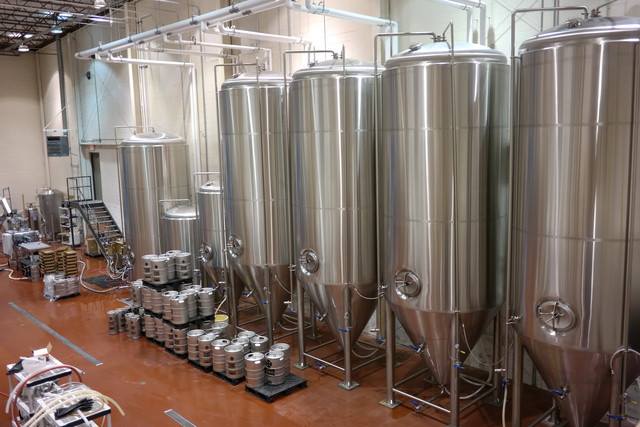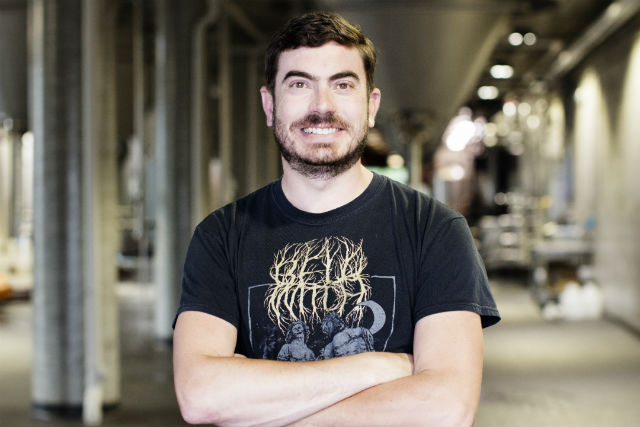
Sugar Creek Brewing functions with old, used equipment, but the Charlotte brewery is blending the knowledge of its in-house Master Cicerone and heaping a load of new technology to drive the company forward.
Describing its philosophy as having the watchful eye of a Trappist Monk with the technical precision of a nuclear engineer, Sugar Creek — started by Eric Flanigan and Joe Vogelbacher in 2014 — sees growth not just in the Carolinas, but overseas as well with an intentional portfolio for Europe while continuing to innovate back home.
The two key innovation points are the brewery’s involvement with data collection and interpreting by teaming with IBM Watson IoT and Bosch while using Vogelbacher’s palate and mind as the 19th Master Cicerone in the world to develop the brewery’s portfolio.
Sugar Creek partnered with IBM and Bosch initially to find solutions to foaming problems in the bottling line. After that, they worked with technology to help identify problem points in the brewery’s chilling protocols and flow systems.
“We’re only a small little brewery and thinking that we could afford to work with a mega big partner like IBM was just never in our reach,” Vogelbacher said. But when Vogelbacher — a member of the Navy Reserves and Flanigan, a member of the Marines – talked with IBM, the idea of doing such data collection was in the conceptual phase. So Sugar Creek was able to partner with the companies by purchasing some equipment and giving access to their facility and shut down operations for some beta testing.
“They basically put some sweat equity in and Bosch came in and provided some sensors,” Vogelbacher said. “When we had a conversation — over a beer, of course — you think, well, this all sounds cool, but I’ll believe it when I see it.”
Now, it’s been a collaborative effort that’s been going on a little over two years.
“What they’re looking to do now is more data analytics and getting these things like predictive maintenance and trying to determine there’s a problem before it actually occurs,” Vogelbacher said. “So downstream is where you add value, that’s where the AI comes in to play and says, ‘Hey, look at this before you package that product.’”
This isn’t anything unheard of to combine these metrics, but usually, it’s macro breweries or very large craft breweries getting into such data-driven analytics. But Sugar Creek produced just a tad more than 5,500 barrels in 2019 according to the Brewers Association. And state-of-the-art isn’t what you would describe the brewing equipment as either.
“We’re actually a very old brewery considering we bought the brewery used from Olde Mecklenburg right down the street when they expanded and Olde Mecklenburg pieced this brewery together from Southend Brewing, which was one of the first breweries in Charlotte,” Vogelbacher said. Some of our tanks are probably approaching 30 years old. So we’re one of the least automated in many aspects, but in some aspects, we’re the most automated.
“So it’s an interesting dichotomy.”
Initially, they started with Sugar Creek’s bottling line.
“It’s crazy because we’re now retiring our bottling line,” Vogelbacher told Brewer in an interview in early June. Since the brewery has moved almost entirely to cans during the pandemic but has started to be able to bring kegs back into the fold as well.
“We have tons of money and time invested in [the bottling line] to decrease slippage and the amount of dissolved oxygen, get a more and better quality product on the shelf, and now it’s moving to cans. So we’re now into a position where we’re switching over from the AI on the bottling line to the AI in the canning line. In the meantime, we’re focusing on cellar operations.“
One thing the sensors continuously monitor is all the fermentation temperatures. Unlike a similar small craft brewery, the cellarman or Brewmaster walks through all the tanks and will take a sample, record gravity, take the pH, time, temperature, and record it all on a log, maybe twice a day.
“Think about the resolution on what’s happening in that beer,” Vogelbacher said. “It’s a few data points, twice per day. Now imagine if you could take that same data point every minute … even every 10 seconds continuously. The resolution that you have on what’s going on in that tank has now increased a million fold.“
Cleaning cycle times also changed drastically. “That was one of the first things I noticed,” Vogelbacher said.“You want to hold the fermenter at 145 degrees for 30 minutes or something like that, right? Now I have a graph. I can go on my phone or anywhere, pull up the tank, look at the temperature graph and see if you hit the minimums for the standards.”
The brewery has some alerts set up and they call them Watson orbs.
“We’ll have alerts now that will say, hey, you’re in a cleaning cycle here; you didn’t meet the minimums and they’ll flag that tank. So that’s proactively letting us know we didn’t meet our cleaning cycle time. And that can influence quality.
“Another big thing is how fast you control the temperature increases and decreases in the tank, all that stuff influences flavor.“
And it helps the brewers manage their workload, added Flannigan.
“We’re very much hands-on,” he said. “Joe and I’ve been to all the big breweries, they are amazing. We dream of having a brewery that big one day, but we go out there sometimes and these brewers are tired, you know? They’re lugging around hoses, they’re going from packaging in the morning to cellaring in the afternoon.
“[The sensors and data] give them an extra level of confidence.“
The big step was Phase 1, where the brewery was able to drive down slippage and dissolved oxygen levels, increase shelf life, improve quality, and save money on the bottling line.
Now, Phase 2, which began in early August will install more equipment for complete remote monitoring and control of the cellar.
Phase 3 will include blockchain tracking for the brewery’s cooperage.
“In a perfect world not only would I know where the keg is, and I don’t have a technological solution for this yet,” Vogelbacher said. “I know there are some things out in the market, but I’m exploring it with Bosch right now that not only we know where the kegs are, but we get an idea when they need to be swapped out, as well.”
So the technology to help the brewery move ahead has been a key asset, but Vogelbacher’s mind is another. He recently passed his Master Cicerone exams and became only the 19th person in the world to hold the prestigious title.
“I was just trying to learn more about beer and become better at my job,” he said when asked why he decided to pursue moving through all four levels of the certification. “We owe it to our customers, especially in a market where it’s saturated with a lot of other breweries and more and more opening every single day.
“How can you make great beer if you can’t taste it and continue to taste it? You’ll meet some guys that have trained at Weihenstephaner and took sensory in 1974. Great, but it’s not something that you can just do once. It’s like saying, ‘I ran a marathon once so I can do it forever the rest of my life, anytime.‘ No, you got to stay up on it. You got to do the spikes. Keep your nose fresh.“
Achieving such an accomplishment takes time though, and Vogelbacher credits Flannigan for covering for him while he would spend most mornings working on studying for the Cicerone tests, an average of four hours a day for four to five months.
Vogelbacher passed on his third time through the test. He narrowly missed the mark the first time in 2017 and his journey was documented in the movie “Beers of Joy,” which was released in early 2019 and premiered online in March 2020.
“It was bittersweet for me but because I went through the whole thing and I ended up being the Black Swan of the film and not passing the exam,” he said. Vogelbacher also had to defend the brewery for being in it because it was announced after the production began that Anheuser Busch became a financier for the project to help give it some legs.
“We had some good media, but some blasted us for being essentially an AB commercial which I thought was funny because as a ‘character’ in the film I was there for everything and there was nobody from AB doing product placement or anything like that,” Vogelbacher said. “You could see me clearly wearing Sugar Creek shirts. There was no influence from them at all. We worked directly with the movie producers.
“I didn’t ask before we agreed to be in the film and ask to see who had a partnership in this film. I was just like, ‘Oh, a movie about beer? Yes. I want to do that.’”
In the end, Vogelbacher feels it did a good job capturing Sugar Creek as an independent brewery.
“I think it was great exposure for us,” he said. “And I think we did what we always do, which is promote and defend craft beer.
“So regardless of who funds it, if we could accomplish our mission, then I would do it [again]. Yeah, as simple as that. It turned out to be, I thought, really good.”
Now the brewery continues to forge ahead in flavor development, utilizing the data mining power IBM Watson. The tech company had already developed a program to help home cooks figure out what to make based on what they had in the pantry. Much like this home chef program, Sugar Creek is working with fellow Charlotte-based company Untappd to use the 50 different data points from user check-ins to help create a new beer for the brewery, which will be called IPAi, slated for a Spring 2021 release.
“We’re definitely invested in making this come to reality,” Vogelbacher said. “We should make sure we do it right the right way. They export all this data to a gigantic spreadsheet. But one part of their database that they do not currently mine is the comment section. So what I’m working with IBM and their IoT team is to scrub the comment section on check-ins, and get positive keywords to correlate those to the ratings.”
What Sugar Creek would like to do is take that info and marry that with specific production parameters that produce the beers that are checked in.
“Now we can dive in and say, ‘Oh, this set of conditions produce higher ratings on Untappd. Let’s focus on that.’
“The larger scheme is we can analyze all the data of all the different beers and brands and you want to make just the best hazy IPA. Now that we have a data set for our own production parameters. Let’s match those up with 500 other breweries across the United States and see if we can’t drive a formula that would result in a better consumer experience.”




2 Trackbacks / Pingbacks